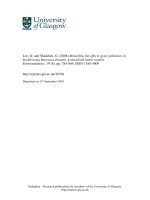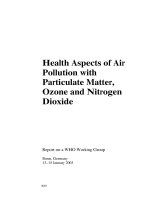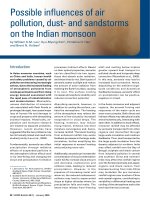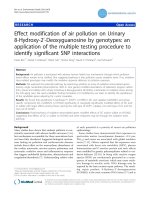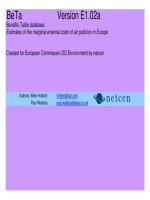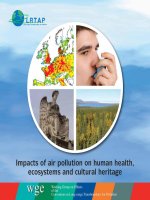Using lichen as bioindicator of air pollution: Acid deposition Monitoring and Assessment Third country Training pptx
Bạn đang xem bản rút gọn của tài liệu. Xem và tải ngay bản đầy đủ của tài liệu tại đây (2.62 MB, 23 trang )
1
Using lichen as bioindicator of
air pollution
Presented at
JFY 2003
Acid deposition Monitoring and Assessment
Third country Training
by :
Dr. Kansri Boonpragob
Department of Biology
Ramkhamhaeng University
Bangkok, Thailand
Path way of pollutants in the atmosphere
O
2
O
2
O
2
Source
Transport & Transform
Sink
Ecosystem
Plant
Animal
Human
SO
2
SO
2
H
2
O
H
2
O
NO
x
NO
x
H
2
SO
4
HNO
3
etc.
2
Brief history of using lichens as
bioindicator of air pollution
Other air pollutants, NO
x
, O
3
, heavy
metals, HF, organic pollutants,
caused disappearance of lichens
from cities & industrial areas.
In 1866 it was noted that lichens
disappeared from Jardin de Luxembourg
near Paris.
* Smoke from burning of coal was the
course.
* SO
2
from burning coal damaged to
lichens.
* Lichens have been used as bioindicator
of air pollution world wide
Background : What are lichens ?
• Lichens are epiphyte
• They live on surfaces of bark,
rock, soil and several substrates
3
* Lichens depend on atmospheric moisture : rain , fog &
dew for growth
* Lichens are sensitive to
air pollution
* Pollutants in the air dissolved in
atmospheric water are damaged
to lichens
Ramalina farinacea
Lichens are differently sensitivity
to air pollution
Fruticose:
The most
sensitive
Foliose:
The second
Crustose:
The most
resistance
4
* Fruticose lichens are the most sensitive:
Lichens are differently sensitive to air pollution
* They are the first group to
disappear from polluted areas
Lichens are differently sensitive to air pollution
* Foliose lichens are the second group to
disappear from polluted area
5
• Some of them thrive well in the polluted cities
These are
Lichens are differently sensitive to air pollution
Crustose lichens are the most resistance to air pollution
* In Bangkok : 7 species have been recorded
* In Europe : Lecanora conizoides
How to use lichens as bioindicator of
air pollution & acid deposition
2. Physiology changes: changes in chlorophyll
content & photosynthesis at various air qualities
Æ fast response
There are two alternative methods:
1. Community changes: changes in species
composition at different levels of pollution
Æ slow response
6
Lichen Community changes
* Identify species of the
lichens
* Change in species composition of lichens at
different levels of pollution
* Explore lichens at various distances i.e. 1 km, 5 km, 20
km, 50, 100, 300 etc km around sources of pollution :
cities, industrial plants
Transect showing that the number of lichens growing on the tops of
sandstone walls, on asbestos roofs, and on ash trees decline as
New Castle is approached from the west (From Gilbert 1965)
Sand stone
Roof
Ash tree
7
Relative cover and biomass of two lichen species on ash trees along an east –
west transect to the west of New Castle, England (From Gilbert, 1969)
biomass
cover
Evernia punestri
Lecanora conizaoeides
cover
Lichen desert:
Map of the Tyne
Valley showing
the concentric
lichen deserts:
on asbestos, on
sandstone, and
on ash trees.
A
s
h
t
r
e
e
s
S
a
n
d
s
t
o
n
e
R
o
o
f
8
00000000112232554576666
%
cover
sensiti
ve
lichen
4.03.03.63.43.93.43.63.33.63.94.44.44.34.34.24.2pH
011.734.766.57899.510.512.514.516.519
Distan
ces
(miles)
pH from bark of ash trees and lichen covers along distance from the city
of New Castle to the west
A transect from Bangkok to Khao yai National Park
shows four lichen collecting localities
Bangkok
Urban
Rajamongkol
Inst. Tech
Sub urban
Phra tamnak
temple,
Nakornnayok
Rural
Khao yai
National Park
Remote
9
A transect from Bangkok to Khao yai National Park to explore
lichen communities on 20 trees at each collecting site
55 (520)2087
No. of
species
Khao yai
National
Park
Phra
tamnak
Temple
Rajamongkol
Inst.
Kasetsart
Univ.
Places
RemoteRuralSuburbanUrbanCategories
2001005010
Distances
from city
center (km)
Lichens found in polluted cities
Europe
Lecanora conizoides
L. dispersa
L. erysibe
Candelariella aurella
Thai
Dirinaria picta
Buelia punctata
Laurera bengaulensis
Lecanora pallida
Trypethelium tropicum
Graphis liberta
Cryptothecia sp.
10
Lichens found in polluted cities in England
Lecanora conizaoeides
Candelariella aurella
Lecanora dispersa
Lecanora erysibe
Lichens found in Bangkok
Buelia punctata
Dirinaria picta
Laurera bangaulensis
Cryptothecia sp.
Lecanora pallida
Trypethelium tropicum
Graphis liberta
11
Species composition of lichen changes
from the city to rural area
Transect from inner city to suburb
and rural area indicated that
number of species increase with
distance away from the city
No. of species related to SO
2
concentration
Ambient SO
2
concentration and air quality index as indicates by presences of
lichen communities in England (Hawksworth and Ross, 1970)
Parmelia caperata, rich in species of Pertusaria, Parmelia
tiliacea, Graphis elegans, Pseudovernia furfuracea, Atectoria
fuscescens
6 ~ 50
Hypogymnia physoides, P.saxatilis, P. glabratula, P.
subrudecta, Parmeliopsis ambigua, Lecanora chlarotera,
Calicium viride, Leparia, candelaris, Pertusaria amara,
Ramalina farinacea, Evernia prunastri
5 ~ 60
Hypogymnia physoides and/or Parmelia saxatilis, or P.
sulcata appear on the bases but not extend up the trunks.
Lecidia scalaris, Lecanora expellens and Chaenotheca
ferruginea
4 ~ 70
Lecanora conizaeoides extends up the trunk; Leparia incana
become frequent on the base
3 ~ 125
Plerococcus viridis extends up the trunk, Lecanora
conizaeoides present but confined to the base
2 ~ 150
Pleurococcus viridis present but confined to the base1 > 170
Epiphytes absent0 ?
Lichens/ EpiphytesZone SO
2
(µg m
-3
)
12
L. amplissima, L. scorbiculata, Sticta limbata,
Panaria spp., Usnea articulata, U. filipendula,
Teloschistes flavicans, abundant
10 ~ pure
Lobaria pulmonaria, L. amplissima, Pachyphiale
cornea, Dimerella lutea or Usnea florida with
crustose > 25 species
9 ~ 30
Usnea ceratina, Parmelia perlata, P. reticulata,
Rinodina robaria, Normandina pulchella, U.
rubigenea
8 ~ 30
Parmelia caperata, P. revoluta, Usnea subfloridana,
Rinodena roboris, Arthonia impolita
7 ~ 40
Lichens/Epiphytes
Zone SO
2
(µg m
-3
)
Ambient SO2 concentration and air quality index as
indicates by presences of lichen communities in England
(Hawksworth and Ross, 1970)
ภาพ porter Lichens & air pollution
ของ British museum
13
•
•
Lichens are identified based on morphology,
Lichens are identified based on morphology,
anatomy and chemical substances
anatomy and chemical substances
Identify lichen species
•
•
Assessing the effects of air pollution on community
Assessing the effects of air pollution on community
change need to identify lichens at the species level
change need to identify lichens at the species level
•
•
Taxonomy of lichens is fundamental back ground
Taxonomy of lichens is fundamental back ground
needed
needed
Assessing the effects of air pollution
Assessing the effects of air pollution
from
from
physiological & biochemical
physiological & biochemical
changes
changes
¾
¾
These are warning signals before
These are warning signals before
severe damages occur, which are
severe damages occur, which are
difficult to correct
difficult to correct
•
•
Degradation of chlorophyll
Degradation of chlorophyll
•
•
Photosynthesis decline
Photosynthesis decline
¾
¾
Provide faster responses to air
Provide faster responses to air
pollution and acid deposition
pollution and acid deposition
14
Lichen composes of algae & fungi living in symbiosis
Lichen
Lichen
Algae
Fungi
* Fungal mycelium assists in
absorbing atmospheric
moisture for algal
photosynthesis and
provides protection to algal
from intense light & UV.
Lichens do not harm the substrates they attacked
because they use simple inorganic matter (CO
2
, H
2
O)
to produce organic matter.
* Algae can photosynthesis produces organic matter.
6CO
2
+ 12H
2
O + light
chlorophyll
C
6
H
12
O
6
+ 6O
2
+ 6H
2
O
15
How air pollution damages plants and lichens
If chlorophyll is destroyed by acid pollutants,
plant produces less 0. M. → reduce growth,
lost protective function against insect & pest
→ death
Chlorophyll is in important organelle function in
absorbing light energy for photosynthesis
producing organic matter.
Comparing leaves damage by SO
Comparing leaves damage by SO
2
2
and normal
and normal
Acid & heavy metals destroy chlorophyll
Insight of how air pollution damages plants
and lichens (at cellular level )
z H
2
SO
4
& HNO
3
enter the leaf via opening stomata
16
Lichens are advantage over vascular plants
as bioindicator of air pollution: because they
have no wax & cuticle to protect cells (inner structure)
Cortex:
fungal
layer
Algal layer
Medulla
Leaf
Lichen
Pollutants
Absorbtion spectrum of chlorophyll and phaeophytin.
Chlorophyll has maximum absorption at 433 and 665 nm.
Acid causes chlorophyll degraded in to phaeophytin, which
maximum absorption shift to 415, and decline at 665 nm.
17
Absorbtion spetrum of chlorophyll & phaeophytin
and mixture of Chl. & Phaeophytin in DMSO.
Prepared from the lichen Ramalina menziesii.
y = -122.91x + 150.26
R
2
= 0.97
0
20
40
60
80
100
0.500 0.700 0.900 1.100 1.300
OD 433/415
% Phaeophytin as % Chl. + Phaeo.
Standard curve for estimation the degradation of chlorophyll into phaeophytin.
Prepared from the lichen Ramalina nervulosa from Khao yai National Park
Mix
PhCh
0100
1090
2080
3070
4060
5050
6040
7030
8020
9010
1000
18
In summer chlorophyll at the
polluted site declined and
phaeophytin increased. Finally,
the lichens at the polluted site
die after chlorophyll completely
degraded. In the wet season
chlorophyll of the lichens at
both sites remained.
The lichen Ramalina menziesii
was transplanted from a
forest out side San Diego
(control site) to Los Angeles
(polluted site).
Lichens & Air pollution
in Los Angeles
Chlorophyll content and
percent phaeophytin from
the transplanted lichens at
both sites were measured.
Lichens & Air pollution
in Los Angeles
NO
3
-
and NH
4
+
leached
from the lichen Ramalina
menziesii collected from
the control site (outside
San Diego) and polluted
site in Los Angeles
19
SO
4
2-
and PO
4
3-
leached
from the lichen Ramalina
menziesii collected from
the control site (outside
San Diego) and polluted
site in Los Angeles
Lichens & Air pollution
in Los Angeles
Chlorophyll content of the
lichen Ramalina menziesii
at the polluted site had high
correlation with the amount
of NO
3
-
accumulated in the
thallus (r = 0.94).
Chlorophyll content at the
control site correlated with
Na (r = 0.65).
Lichens & Air pollution
in Los Angeles
20
Example of using
chlorophyll degration
to assess air pollution
in Bangkok
(in 1988)
Transplanted lichens
from Kao Yai National
Park to
- Bangkok
(polluted site)
- Bang pa – in
(control site)
Meansured chlorophyll
& % phaeophytin
Example of
Using
chlorophyll
&
phaeophytin
assessing
air quality
(In 2002)
Measured chlorophyll &
phaeophytin in lichens
along transect Between
Bangkok Khao Yai National
Park
A
Bangkok
B
50 km
C
100 km
D
KYNP, 200 km
21
S content of Parmelia saxatilis from
different part of the Tyne valley
225569142028703290
S content
(ppm)
2186.254.54
Distances west of town center
(miles)
Accumulation of Pb in lichen thalli and
photosynthetic responses
540.6057015
1001.1060600
260.5448815
1002.0865600
Parmelia
physoides
572.3628315
1004.1233600
(%)
Pn
(mg CO
2
g
-1
h
-1
)
Pb content
(µg g
-1
)
Distances
from motor
way (km)
Lichens
Evernia prunestri
Parmelia caperata
22
Lichen biodiversity index &
lung cancer
Lichen are efficient indicator of air
pollution & acid deposition
They are less cost comparing with
expensive equipments.
Appropriate technique should be
developed especially in
developing countries to use
lichens as bio-monitoring of air
pollution
Lichens provide warning signal
before severe damages occur on
ecosystem & health.
Conclution
23
Thank you
for your
attention
www.ru.ac.th/lichen


